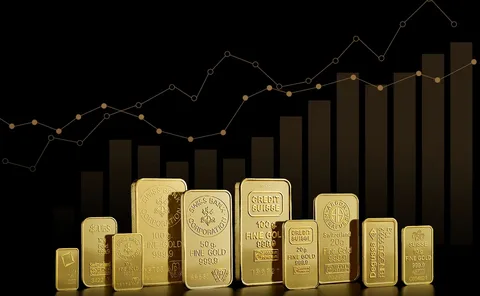The price of gold has reached an unprecedented milestone as it soars to a record high, surpassing the $2000 mark. This significant increase has captured the attention of investors and market analysts alike, sparking a surge in interest and speculation. The soaring price of gold reflects a variety of economic and geopolitical factors, making it a crucial topic for individuals and businesses involved in the precious metal industry. In this article, we will delve into the reasons behind this remarkable price surge and explore the potential implications for the global economy.
The surge in gold prices to a record high above the $2,000 mark is driven by a combination of factors including a weakening US dollar, global economic uncertainty due to the COVID-19 pandemic, and low interest rates. Investors are turning to gold as a safe haven asset to hedge against inflation and market volatility. The last time gold hit a record high was in 2011. Analysts expect gold prices to continue rising in the near term as the uncertain economic outlook persists.
Understanding the Fluctuating Price of Gold

Gold has long been considered a safe haven investment, with its price being influenced by a multitude of factors. Economic conditions, political events, and even central bank policies can all have a significant impact on the price of gold. Investors closely monitor gold price charts and use various analytical tools to predict future price trends. In times of uncertainty and market volatility, the price of gold tends to rise as investors seek out its stability. However, environmental and social costs of gold mining also play a role in determining the price of gold.
Understanding the fluctuating price of gold is a complex task that involves analyzing various economic, geopolitical, and market factors. Some key factors that can impact the price of gold include inflation rates, interest rates, global economic stability, geopolitical tensions, and supply and demand dynamics.
Inflation rates have a significant impact on the price of gold, as investors often turn to gold as a store of value during times of high inflation. Similarly, interest rates can also influence the price of gold, as higher interest rates can lead to lower gold prices, while lower interest rates can lead to higher gold prices.
Global economic stability and geopolitical tensions can also impact the price of gold, as investors often turn to gold as a safe-haven asset during times of economic uncertainty or geopolitical turmoil. Additionally, supply and demand dynamics in the gold market can also impact its price, as changes in production levels, mining output, and consumer demand can all affect the supply and demand balance.
Overall, understanding the fluctuating price of gold requires a deep understanding of the various factors that can influence its price, as well as the ability to analyze and interpret economic and market data to make informed investment decisions.
The Impact of Economic Conditions on Gold Prices

The impact of economic conditions on gold prices is multifaceted. In times of economic uncertainty or instability, investors tend to flock to gold as a safe-haven asset, driving up its price. This is due to the perception that gold holds its value better than other assets during times of economic turmoil. Additionally, high inflation or a weakening currency can also drive up demand for gold as a hedge against loss of purchasing power. Conversely, during periods of strong economic growth and market stability, the demand for gold may decrease, causing its price to fall. Overall, economic conditions play a significant role in influencing the price of gold.
Predicting Future Price Trends for Gold
See also: metal detector gold detector

Predicting future price trends for gold involves analyzing a variety of factors that can impact its value. Some common methods used in predicting future price trends for gold include technical analysis, which involves studying historical price movements and chart patterns, as well as fundamental analysis, which involves examining supply and demand dynamics, geopolitical events, and macroeconomic indicators. Additionally, sentiment analysis, which gauges market psychology and investor sentiment, can also play a role in forecasting gold price trends. It’s important to consider that predicting future price trends for gold is inherently uncertain and can be influenced by a wide range of variables.
The Relationship Between US Dollar and Gold Prices

The relationship between the US dollar and gold prices is complex and multifaceted. One common perception is that when the US dollar weakens, the price of gold tends to rise, and vice versa. This is because gold is priced in US dollars internationally, so a weaker dollar makes gold more affordable for investors using other currencies. Additionally, a weaker dollar can also be seen as a sign of economic instability, prompting investors to seek out safe-haven assets like gold. On the other hand, a stronger dollar can make gold more expensive for investors using other currencies, potentially leading to a decrease in demand and a subsequent drop in the price of gold. However, it’s important to note that the relationship between the US dollar and gold prices is influenced by a wide range of factors, including interest rates, inflation, geopolitical events, and market sentiment. As a result, the connection between the two is not always straightforward and can be subject to change based on evolving economic conditions.
Investing in Gold: Is Now the Right Time?
Investing in gold can be a good option for diversifying your investment portfolio, especially during times of uncertainty or market volatility. Historically, gold has been seen as a safe haven asset, and its value tends to rise when other investments, such as stocks, are not performing well.
The current economic climate, with concerns about inflation, geopolitical tensions, and the potential for market corrections, has led many investors to consider adding gold to their portfolios. Additionally, the unprecedented levels of monetary stimulus from central banks around the world have raised concerns about currency devaluation, making gold an attractive hedge against inflation.
However, it’s important to consider that gold prices can be volatile in the short term, and investing in gold may not be suitable for everyone. It’s essential to carefully evaluate your investment goals, risk tolerance, and time horizon before making any investment decisions.
Ultimately, whether now is the right time to invest in gold depends on your individual financial situation and market outlook. It’s always advisable to consult with a financial advisor or do thorough research before making any investment decisions.
Why Do Geopolitical Events Affect Gold Prices?
Geopolitical events affect gold prices due to their impact on investor confidence and market uncertainty. Gold is often seen as a safe-haven asset during times of geopolitical turmoil, as it is perceived as a store of value and a hedge against currency fluctuations. When geopolitical tensions rise, investors tend to flock to gold as a way to protect their wealth, leading to increased demand and higher prices. Additionally, political instability can lead to economic disruptions and market volatility, further driving up the price of gold. As a result, geopolitical events and gold prices are closely linked, with shifts in global politics often leading to fluctuations in the value of the precious metal.
The Psychology Behind Investor Behavior in Gold Markets
The psychology behind investor behavior in gold markets is complex and multi-faceted. Gold is often seen as a safe haven asset, particularly in times of economic uncertainty or geopolitical instability. As a result, investor behavior in gold markets is often driven by emotion and fear, rather than rational decision-making.
One key psychological factor at play in gold markets is the fear of loss. Investors may flock to gold as a way to protect their wealth and hedge against potential losses in other asset classes. This fear-driven behavior can lead to increased demand for gold and drive up its price. Conversely, when economic conditions improve and the fear of loss diminishes, investors may sell off their gold holdings, leading to a decrease in price.
Additionally, the herd mentality can also impact investor behavior in gold markets. When large numbers of investors start buying or selling gold, others may feel pressured to follow suit in order to avoid missing out on potential gains or to avoid losses. This can create a self-reinforcing cycle of behavior that amplifies price movements in gold markets.
Behavioral biases, such as anchoring (where investors fixate on a specific price point) and recency bias (where investors focus on recent events or trends) can also impact investor behavior in gold markets. These biases can lead to irrational decision-making and contribute to price volatility.
Overall, the psychology behind investor behavior in gold markets is influenced by emotions, fear of loss, herd mentality, and behavioral biases. Understanding these psychological factors is essential for both investors and market analysts in predicting and interpreting movements in gold prices.
How to Analyze and Interpret Gold Price Charts
When analyzing and interpreting gold price charts, it is important to understand the various factors that can influence the price of gold. Some key factors to consider include supply and demand dynamics, geopolitical events, monetary policy, and market sentiment.
One commonly used tool for analyzing gold price charts is technical analysis. This involves studying historical price movements and using technical indicators such as moving averages, trend lines, and relative strength index (RSI) to identify potential patterns and trends.
Another approach is fundamental analysis, which involves examining economic data, central bank policies, and other macroeconomic factors that can impact the price of gold.
It’s also important to consider the broader market environment when interpreting gold price charts. For example, gold is often viewed as a safe-haven asset and tends to perform well during times of geopolitical uncertainty or market volatility.
Overall, analyzing and interpreting gold price charts requires a combination of technical and fundamental analysis, as well as an understanding of the broader market and macroeconomic factors that can influence the price of gold.
The Role of Central Banks in Influencing Gold Prices
Central banks play a significant role in influencing gold prices through their monetary policy decisions and actions. For example, central banks can impact gold prices by adjusting interest rates, which can affect the value of the currency and demand for gold as an alternative investment. Additionally, central banks may also buy or sell gold as part of their foreign exchange reserves, which can directly impact the supply and demand dynamics of the gold market. Overall, the actions and policies of central banks can have a substantial impact on the movement of gold prices in the global market.
The Environmental Costs of Gold Mining and Its Effect on Price
The environmental costs of gold mining include habitat destruction, soil erosion, water pollution, and contamination of the surrounding ecosystems. These activities can also lead to increased greenhouse gas emissions and loss of biodiversity. These environmental impacts can also affect the price of gold by increasing production costs, causing supply disruptions, and impacting the perception of the industry among consumers and investors. As a result, addressing the environmental costs of gold mining is essential for ensuring the long-term sustainability of the industry and the stability of gold prices.
In conclusion, the soaring price of gold reaching record highs and surpassing the $2000 mark is indicative of the increased demand and investment in this precious metal. The uncertain economic climate and global instability has driven investors to seek out the stability and security of gold, leading to its remarkable surge in value. As the price of gold continues to rise, it remains a key indicator of market trends and a safe-haven asset for investors worldwide.
See also
https://www.bullionbypost.fr/cours-de-lor/cours-de-lor-actuel/
https://or.fr/cours/or
https://www.aucoffre.com/cours-or
https://www.bullionbypost.fr/cours-de-lor/cours-de-lor-aujourdhui/
https://or.bullionvault.fr/Cours-De-L-Or.do
https://www.orobel.biz/cours-metaux-precieux/cours-or-prix-or
https://www.orencash.fr/cours-de-l-or/